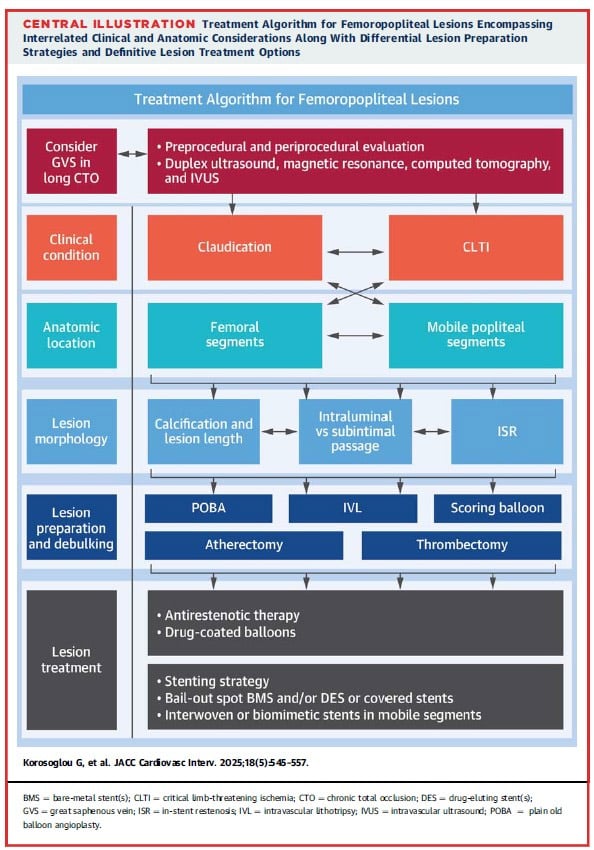Global algorithm for the endovascular treatment of chronic femoropopliteal lesions
Selected in JACC: Cardiovascular Interventions by Marc Lin
Endovascular treatment of chronic femoropopliteal lesions involves a variety of techniques but lacks a standardised therapeutic algorithm.
After crossing total occlusions, vessel preparation and treatment options range from atherectomy and intravascular lithotripsy to angioplasty with drug-coated balloons and various stent types. Based on expert consensus using the Delphi method, this article proposes a global algorithm that integrates pre- and peri-procedural imaging, lesion preparation, and definitive treatment choices.
This individualised approach seeks to optimize clinical outcomes according to lesion and patient characteristics, highlighting the need for further high-quality studies to refine best practices.
References:
Authors: Grigorios Korosoglou, Andrej Schmidt, Michael Lichtenberg, Nasser Malyar, Konstantinos Stavroulakis, Holger Reinecke, Gerd Grözinger, Lorenzo Patrone, Ramon L. Varcoe, Peter A. Soukas, Dittmar Böckler, Christian-Alexander Behrendt, Eric A. Secemsky, Thomas Zeller, Erwin Blessing, Ralf Langhoff, and Christos Rammos
Reference: J Am Coll Cardiol Intv. 2025 Mar, 18 (5) 545–557
DOI: doi/10.1016/j.jcin.2024.11.038
Read the abstractBackground:
Chronic femoropopliteal lesions are challenging to treat endovascularly due to lesion complexity and lack of standardised therapeutic algorithms. Although previous algorithms exist for crossing chronic total occlusions, no consensus guides post-crossing treatment strategies.
Objective:
To develop a global, expert-driven algorithm for the endovascular management of chronic femoropopliteal lesions that standardises lesion preparation, imaging, and definitive treatment approaches.
Methods:
A Delphi consensus method involving multiple rounds of expert surveys was used to evaluate clinical scenarios, imaging modalities, lesion preparation techniques, and treatment options, aiming to achieve consensus on best practices.
Outcomes:
The consensus established recommendations for imaging protocols, lesion preparation tools (e.g., atherectomy, intravascular lithotripsy), and definitive treatments including drug-coated balloons, bare-metal and drug-eluting stents, and covered stents.

Curious to know more? Tune in to one of the brains behind the algorithm!
Get the latest clinical cases and breaking news delivered straight to your inbox!


Discussion:
While drug-coated balloons emerged as the preferred treatment for many lesions, the choice of strategy depends on lesion characteristics, calcification severity, and patient factors.
Evidence gaps remain due to limited randomised trials, especially comparing new devices and complex lesion treatments.
Conclusion:
This algorithm offers an individualised approach integrating lesion morphology, preparation, and treatment options.
It emphasises operator expertise and device availability, acknowledging no universal solution yet exists for chronic femoropopliteal lesion management.